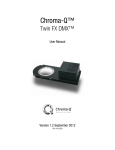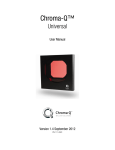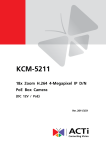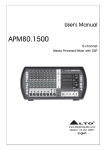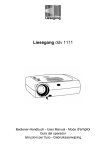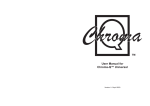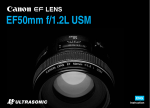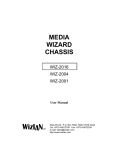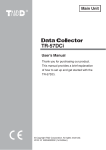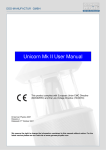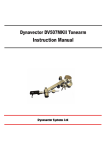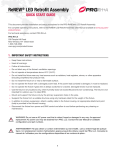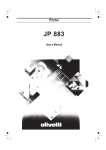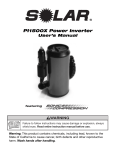Download Chroma-Q™
Transcript
Chroma-Q™ Cascade™ User Manual Version 1.2 December 2006 PN: 109-0500 Disclaimer The information contained herein is offered in good faith and is believed to be accurate. However, because conditions and methods of use of our products are beyond our control, this information should not be used in substitution for customer's tests to ensure that Chroma-Q products are safe, effective, and fully satisfactory for the intended end use. Suggestions of use shall not be taken as inducements to infringe any patent. Chroma-Q sole warranty is that the product will meet the sales specifications in effect at the time of shipment. Your exclusive remedy for breach of such warranty is limited to refund of purchase price or replacement of any product shown to be other than as warranted. Chroma-Q reserves the right to change or make alteration to devices and their functionality without notice due to our on going research and development. The Chroma-Q Cascade has been designed specifically for the professional entertainment lighting industry. Regular maintenance should be performed to ensure that the products perform well in the entertainment environment. If you experience any difficulties with any Chroma-Q products please contact your selling dealer. If your selling dealer is unable to help please contact [email protected]. If the selling dealer is unable to satisfy your servicing needs, please contact the following, for full factory service: Outside North America: Tel: +44 (0)1494 446000 Fax: +44 (0)1494 461024 [email protected] North America: Tel: 416-255-9494 Fax: 416-255-3514 [email protected] For further information please visit the Chroma-Q website at www.chroma-q.com. Chroma-Q is a trademark, for more information on this visit www.chroma-q.com/trademarks. The rights and ownership of all trademarks are recognised. Cascade User Manual 1 V1.2 December 2006 Table of Contents 1. Product Overview ……………………..………………………….………................ 3 2. Operation ……………...…………………………………………………….…….….. 3 2.1 DMX addressing ………………………………………………………………. 3 2.2 Control and power cables ……………………………..……………….…… 4 2.3 Troubleshooting …..…………………………………………………………... 5 2.4 Gel loading / replacement ……………………………………………..…… 6 2.5 Technical overview ………………………………………………………...... 8 2.6 Technical specifications ……………………………………………………... 9 3. Charts …………………………………………………………………………………. 10 3.1 Colour chart (Library mode) ……………………………………………….. 10 3.2 Colour chart (Creative mode) ……………………………………………... 10 Cascade User Manual 2 V1.2 December 2006 1. Product overview The Chroma-Q Cascade is a scrolling colour changer designed to operate on the ANSI E1.11 USITT DMX 512-A protocol. This multiplexed serial data system allows for the individual addressing of multiple units on one data cabling system. The unit utilises one or two DMX channels depending on the mode of operation. The unit is addressed by setting the three rotary BCD switches, on the rear panel. Next to these rotary switches are four DIP switches. These switches are used to select mode of operation, scrolling speed, & cooling fan speed. (Details of these settings are given later in section 3.1) The unit operates using subtractive colour mixing method. This method relies on having a full spectrum source (white light) & then filtering out some of the colours to achieve the desired hue & saturation. The secondary (subtractive) colours are Cyan, Magenta & Yellow. By mixing two of the basic subtractive filters at different saturations, you are able to mix hundreds of different colours within one unit. To further the creative process, the primary (additive) colours (red, green & blue) have been added to the back gel string. This unit combines the secondary colours by using two gel strings. The choice was made to get maximum reliability, maximum light output & to keep the dimensions & weight to a minimum. The Chroma-Q Cascade is supplied power & control signals by means of two 4-pin XLR style connectors on the rear panel, allowing multiple units to be daisy-chained into the same line of cabling. Patching the output from the last unit back into the power supply will terminate the DMX for each chain line & ensure even power voltage across all scrollers in that chain. Note: The quantity of Chroma-Q Cascade colour changers, & maximum cable length per power supply output is dependant upon the size of PSU/splitterbox used (see later in this manual for details). The Chroma-Q Cascade is equipped with two internal cooling fans & two diagnostic LED indicators (found on the underside of the unit) showing Power & DMX signal presence. 2. 2.1 2.2 2.3 2.4 2.5 2.6 Operation DMX addressing Control and power cables Troubleshooting Gel loading/replacement Technical overview Technical specifications 2.1 DMX addressing The unit is addressed by setting the three rotary switches to the required DMX address. Remember to allow for the number of channels used, which is dependant on the units mode of operation. (See below) Modes of operation The Chroma-Q Cascade has two modes of operation, Creative mode & Library mode. The Creative mode is enabled by setting dipswitch #1 to the "off" position. In this mode you use one DMX channel to control the each individual colour string, giving you maximum flexibility. The first DMX channel will control the front string (Yellow-Cyan) & the Cascade User Manual 3 V1.2 December 2006 second DMX channel controls the back string (Yellow-Magenta). You can speed up the movement of the scrollers by turning dipswitch #2 on in this mode. The Library mode is design to give you quick access to a 100 pre-programmed colours. Turning on the dipswitch #1 "on" will give you access the Library mode. This is achieved by entering a percentage value in the console (from 0% to 100%). You can refer to the chart (section 5.1) to find which percentage matches with which colour. In this mode dipswitch #2 will select between fixed speed between colours when it is in the "off" position, or variable speed controlled by the next DMX channel if it is in the "on" position. SW1 SW2 SW3 SW4 OFF OFF OFF ON X X X X Mode Creative Regular gel speed High gel speed ON ON OFF ON X X X X Library Fixed gel speed Controlled gel speed X X X X X X X X OFF ON OFF ON OFF OFF ON ON DMX Channels 2 2 2 1 or 2 1 2 Fan Speed High fan speed Medium fan speed Medium fan speed Low fan speed Note: a) Do not power lights without powering up the scroller first. Fan must be running in order to protect gels from premature failure. b) High fan speed is recommended on all lighting fixtures of 750 Watts & above. c) Use of a high quality IR filter medium on ellipsoidal lighting fixtures is strongly recommended, especially those with beam angles of less than 30 degrees. 2.2 Control and power cables The Chroma-Q Cascade utilises an XLR 4-pin cable system. This is used for power & data transfer. Pins 2 & 3 are for ANSI E1.11 USITT DMX 512-A data. Pins 1 & 4 are for 24VDC power. Note: It is very important to ensure that the drain wire from the cable shield is connected to both XLR connector cases. When assembling XLR 4-pin cables, heat shrink should be used on each individual pin to prevent short circuits. Damage will occur if power connections short to data connections (see below). Detail of connector wiring The correct wiring between male & female connectors is 'one to one'. Cascade User Manual 4 V1.2 December 2006 Pin # 1 2 3 4 Chassis Pin # Ground (-ve) Control data minus (-) Control data plus (+) 24V DC (+ve) Cable shield/drain wire Minimum Cable size 2.00mm² (14 AWG) 0.35mm² (22 AWG) 0.35mm² (22 AWG) 2.00mm² (14 AWG) 0.25mm² (24 AWG) Note: Cable length should not exceed more than 60m/200' with return line. Connections Correct connection of the units to the power supply will decrease the chances of units malfunctioning due to cabling problems. Please follow these basic rules. a) Use the type & gauge of cable with proper connectors. b) Keep cable runs as short as possible to reduce line loss. c) Always use a return cable for each run. This will ensure balanced DC power to all units, that the line is correctly terminated, & all units receive power if one link of the chain is faulty. 2.3 Troubleshooting The 2 LED indicators aid in the trouble shooting of the Chroma-Q Cascade system. Green LED indicator = data, red LED indicator = power. These LED indicators are located on the on the underside of each unit. Symptom Possible Cause Solution Unit does not respond to Rotary switch settings may Check rotary switch settings. DMX control, but green DMX not be correct. LED indicator is on. Wrong address selected. Unit does not respond to Bad cable. No DMX present Check cable & DMX run from DMX & green DMX LED at Splitter/PSU unit. console. indicator is off. Units run at different speeds. Dipswitch settings may be Check dipswitch settings. different. Cable lengths are Check the cable length too long. configuration. Ensure there is a cable return line in the system. Units have dim LED Overloading of colour Check voltage levels on last indicators & run slowly changer chain or cable runs unit. Should not be below too long. PSU overloaded. 20VDC. Green DMX LED indicator is Bad cable or blown Check cable or send unit for off on one unit. transceiver IC in the scroller. repair. Only one gel string runs. Mechanical (or electrical) Turn unit on & off. Return unit failure in the unit. for repair. Gel burns too quickly. Fans have failed. Poorly Check fans are operating. optimised lamp focus in Optimise lamp focus. Replace fixture. IR filter medium not gel strings & install IR filter. fitted. Cascade User Manual 5 V1.2 December 2006 Note: A high percentage of problems are a direct result of poor cable & corrupt DMX control signals. 2.4 Gel loading/replacement Note: a) See also the drawing section (4.1) of this manual. b) The power does not have to be on to load gels. Introduction The Chroma-Q Cascade comes with two specially graduated colour strings already installed. Should these gel strings become damaged or worn out they must be replaced to ensure the optimum performance of the colour scroller. The gel material is a proprietary design long-life substrate. Replacement gel strings may be purchased from your dealer. Substitute gels strings should not be used as these will effect the operation of the unit & may cause damage to the unit itself. Each gel string consists of two series of graduated colours. The rear gel string (yellow/magenta) starts with yellow, then clear in the middle, then magenta at the end (plus primary red, green, & blue). The front gel string (yellow/cyan) starts with yellow, then clear in the middle, then cyan at the end. Changing the gel strings is not difficult, but it may take some time & practice to accomplish, if the user is not familiar with these types of scrollers. You will need: 1 x Set of Chroma-Q Cascade gel strings 1 x Roll of flat back adhesive tape (i.e. 'Artists' tape) 1 x Phillips No.1 screwdriver Preparation 1. Unplug the unit & remove it from the lighting fixture to which it is attached. Using a Phillips No. 1 screwdriver, remove the four M3 × 4mm screws holding the front cover onto the unit. Place the unit, with the mounting plate facing down, on a flat surface & carefully remove the front cover. Cascade User Manual 6 V1.2 December 2006 2. Remove all the pieces of the old gel strings. This may involve unwinding the gels from the Take-Up Reels (TUR). Exercise caution to avoid damaging the gel transport mechanism. Replacing the rear gel string (yellow/magenta) Note: See the drawing section of this manual. 1. Place the unit on a flat surface with the motor/fan/electronics section on your right-hand side. Take the yellow/magenta gel string & attach the gel tab (on the yellow end) to the hook on the TUR (Take-Up Reel) anchor of the rear fixed shaft. 2. Use a small piece of flat back tape 25 x 25mm (1" x 1") to secure each side of the gel to the TUR hubs on either side. 3. Manually turn the fixed gear of the shaft to slowly roll the gel string onto the TUR. Continue rolling the gel onto the TUR until the other end is reached. 4. Firmly holding the gear of the rear fixed shaft to stop it moving, gently pull the gel tab towards you. This ensures that the gel is tightly on the TUR. 5. Rotate whole the unit so that the motor/fan/electronics section on your left hand side. Place the gel tab beside the anchor on the rear spring shaft. 6. With your left hand, firmly hold the gel tab next to the anchor hook (do not attach it yet). With your right hand, turn the anchor hub of the spring shaft towards you counterclockwise for five complete turns (as you turn the shaft you should feel the spring tension increasing). 7. After tensioning, hold the anchor steady & hook the gel tab onto the anchor. 8. Use a small piece of flat back tape 25 x 25mm (1" x 1") to secure each side of the gel to the TUR hubs on either side. 9. Manually roll some of the gel string onto the spring TUR to check it is seating itself properly. Replacing the front gel string (yellow/cyan) 1. Place the unit on a flat surface with the motor/fan/electronics section on your left-hand side. Take the yellow/cyan gel string & attach the gel tab (on the yellow end) to the hook on the TUR anchor of the front fixed shaft. 2. Use a small piece of flat back tape 25 x 25mm (1" x 1") to secure each side of the gel to the TUR hubs on either side. 3. Manually turn the fixed gear of the shaft to slowly roll the gel string onto the TUR. Continue rolling the gel onto the TUR until the other end is reached. 4. Firmly holding the gear of the front fixed shaft to stop it moving, gently pull the gel tab towards you. This ensures that the gel is tightly on the TUR. 5. Rotate whole the unit so that the motor/fan/electronics section on your right hand side. Place the gel tab beside the anchor on the rear spring shaft. 6. With your left hand, firmly hold the gel tab next to the anchor hook (do not attach it yet). With your right hand, turn the anchor hub of the spring shaft towards you counterclockwise for five complete turns (as you turn the shaft you should feel the spring tension increasing). 7. After tensioning, hold the anchor steady & hook the gel tab onto the anchor. 8. Use a small piece of flat back tape 25 x 25mm (1" x 1") to secure each side of the gel to the TUR hubs on either side. Cascade User Manual 7 V1.2 December 2006 9. Manually roll some of the gel string onto the spring TUR to check it is seating itself properly. Completion and testing 1. Plug in the scroller and check that it goes through the initialisation sequence correctly. Check that the gels run smoothly and do not bind up on the TUR's. 2. Unplug the unit, replace the front cover and secure with the M3 screws. 3. Run a test sequence to allow the gel strings to bed-in. The unit does not have to be attached to a lighting fixture to perform this operation. This sequence can either be programmed on your control desk, or you can use the unit's inbuilt test sequence by setting the address switches to 601. It is recommended that you run this sequence for 10 minutes or 4 times end-to-end. Note: The number of turns may vary slightly between take up reel spools due to tolerances in the tension spring, however no more than five turns should be required to tension gel string. Note: Poorly optimsed lamps in lighting fixtures may result in premature gel failure. 2.5 Technical overview The Chroma-Q Cascade unit is essentially two scrollers in one package. The colour mixing system employs an opto-electronic system for accurate positioning of the gel. When the unit initially receives power, it will go through a calibration sequence. The purpose of the initial calibration sequence during power up is to determine the total length of the gel string, and therefore the position of the different gels. Note: Over time the gel string may warp slightly. This may alter the positions of the gels relative to their pre-programmed DMX values and therefore some fine-tuning may be required. The motors have an optical encoder feedback system. The purpose of which is to convert motor revolutions in to electronic pulses, and also to determine which direction the motor is turning. The electronic cards consist of three key components: L298 motor driver, 75176 Transceiver and a Processor. The L298 is a true digital device receiving two PWM signals to operate speed and direction. The 75176 transceiver operates in the receive configuration to convert serial protocol to a TTL level. The processor is an OTP part containing proprietary software. The majority of electronics problems are usually created by external factors such as shorted cables, etc. The 75176 transceivers are susceptible to damage if 24VDC is present on the DMX signal lines. Routine maintenance can prevent most mechanically based problems. The motor mounting plate can be adjusted to control tension on the belt. Excessive belt tension is often the cause of noise and poor performance. Conversely, loose motor belts can cause accuracy problems. Troubleshooting is a process of elimination. First, rule out the other field factors (i.e. faulty cables, power sources). If an electronics problem is suspected try replacing the electronics card first. If accuracy problems should occur and mechanical problems have been ruled out, replace optical sensors. For technical advice and/or parts, please contact your selling dealer or the offices listed in this manual. Cascade User Manual 8 V1.2 December 2006 2.6 Technical specifications Dimensions: 306mm (w) × 340mm (h) × 100mm (d) 12" × 13.5" × 4" Weight: 2.56kg/5.63lb Rear aperture: 178mm/7" Front aperture: 241mm/9.5" Colour media: Proprietary design long life substrate Cooling: 2 fan design Cooling Speed: 4 speeds DMX protocol: ANSI E1.11 USITT DMX 512-A DMX addressing: 3 × rotary BCD switch (512 channels) Working Voltage: 24VDC (+/- 10%) Power consumption: 1.5 PU (see note below) Connectors: XLR-4 (male) in and XLR-4 (female) through Body material: Aluminium Body color: Black powder coat (other colours available, P.O.A.) Mounting plate: Universal mounting system fits 160mm × 254mm/6¼" x 10" Approvals: EN55103-1 and 2, IEC 60950, FCC Part 15 and ICES-003 Class A Note: To simplify the choice of power supply we use the "PU" (Power Unit) to calculate the load requirements of the Chroma-Q system. For example a PS-08 will supply up to 8 PU's, so you can plug-in 5 Chroma-Q Cascade (5 × 1.5PU = 7.5PU) into a PS-08. Cascade User Manual 9 V1.2 December 2006 3. Charts 3.1 Library mode 3.2 Creative mode Cascade User Manual 10 V1.2 December 2006











